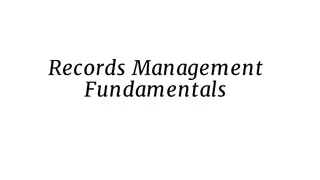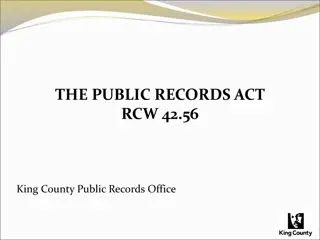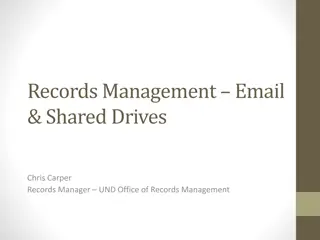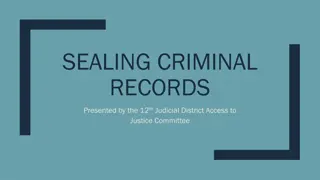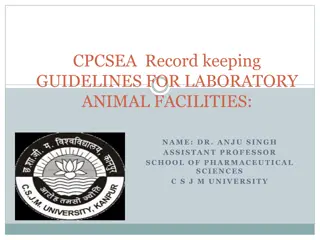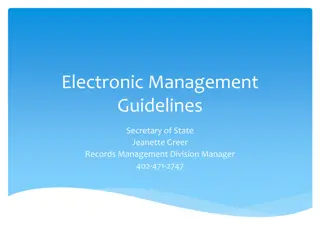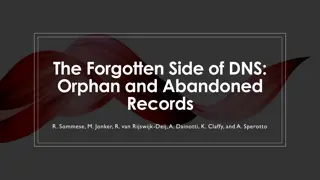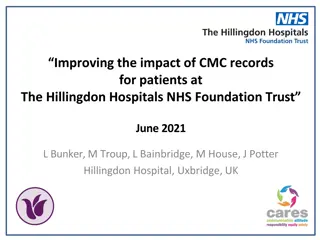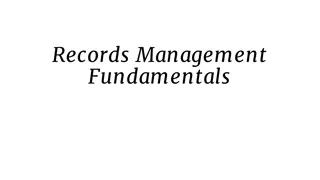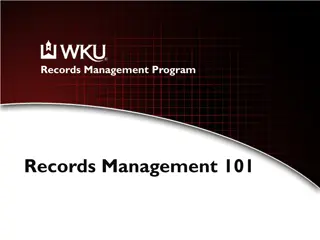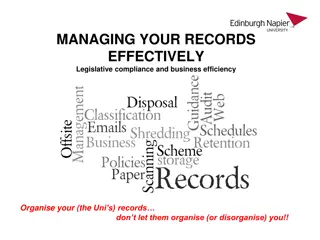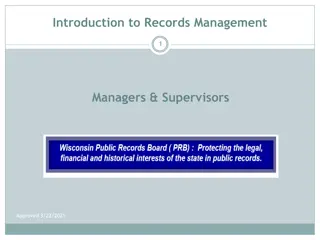Getting Started with Records Management
Records management is a licensed work under the Creative Commons Attribution-NonCommercial-ShareAlike 4.0 International License. It involves understanding the definitions, purposes, stages, policies, procedures, and tools related to managing records effectively. This comprehensive regime encompasses deciding what records to create, organizing them to support business needs, and controlling their lifecycle. Identifying types of records, handling disaster scenarios, and maintaining the qualities of useful records are essential aspects of records management.
Download Presentation

Please find below an Image/Link to download the presentation.
The content on the website is provided AS IS for your information and personal use only. It may not be sold, licensed, or shared on other websites without obtaining consent from the author.If you encounter any issues during the download, it is possible that the publisher has removed the file from their server.
You are allowed to download the files provided on this website for personal or commercial use, subject to the condition that they are used lawfully. All files are the property of their respective owners.
The content on the website is provided AS IS for your information and personal use only. It may not be sold, licensed, or shared on other websites without obtaining consent from the author.
E N D
Presentation Transcript
Where do I start with Records Management? T H I S W O R K I S L I C E N S E D U N D E R T H E C R E A T I V E C O M M O N S A T T R I B U T I O N - N O N C O M M E R C I A L - S H A R E A L I K E 4 . 0 I N T E R N A T I O N A L L I C E N S E . T O V I E W A C O P Y O F T H I S L I C E N S E , V I S I T H T T P : / / C R E A T I V E C O M M O N S . O R G / L I C E N S E S / B Y - N C - S A / 4 . 0 / O R S E N D A L E T T E R T O C R E A T I V E C O M M O N S , P O B O X 1 8 6 6 , M O U N T A I N V I E W , C A 9 4 0 4 2 , U S A .
Agenda The Cycle of Records Management Definitions Purpose of records management Stages of records management Records What should your policy cover? What about procedures? management policies Plans for improvement Records management toolkit Risk based approach Being pragmatic
Introducing you! In less than 30 seconds tell us: Name Organisation + v brief synopsis of what it does
Answers on a sticky note! What is it that concerns you most about Records Management?
Identify your records 1. On separate sticky notes write down the types of records you hold in your organisation, one type per sticky note. (Be fairly specific invoice files not finance records ) 2. Imagine a flood/disaster (plus simultaneous equivalent digital threat) scenario & split notes into 3 categories: Absolutely save Just desert Dither pile
What is a record? A record is any information created or received and maintained as evidence of an action or decision by a person or organization current used for day to day running historical showing what decisions were made & how
Qualities of a useful record authenticity reliability integrity usability
What is records management? a comprehensive regime which controls records through their lifecycle, including: deciding what records to create organising them so that they support business needs and authorised retrieval evaluating and imposing retention requirements documenting destruction or designation as archives Margaret Crockett, The No-nonsense Guide to Archives and Recordkeeping
Aims of records management: Inform decision making Track progress of projects and processes Provide evidence of: Policy Decisions Actions/activity Compliance with rules and regulations Compliance with regulations Institutional memory
Stages of Records Management 1.Creation 2.Organisation 3.Retention 4.Disposal (destruction/archiving) http://www.nationalarchives.gov.uk/documents/information-management/rm-code-guide4.pdf
Creation How to decide what to create Ask yourself if it will help you For different activities: Governance Day to day business Compliance with regulations Prove Remember Protect http://www.nationalarchives.gov.uk/documents/information-management/rm-code-guide4.pdf
Creation: Tips for naming documents Name them sensibly for the relevant activity. Titles should be concise, but contain enough relevant information. Use standard terms or forms for names, places etc.. Use the date format YYYYMMDD or YYMMDD Use whole names, or standard acronyms. If acronyms are used, ensure that the full description is spelt out within the document. Put document path in the footer
Creation: metadata for key records Identity of creator Function of creator Date of creation Location of record Versions
Lay your cards on the table In your groups: The pack of cards in front of you each represent a folder or set of folders for an organisation. Please organise them into logical groupings they may be in a number of layers in a hierarchy and name the groupings and suggest the top level names for each section.
Organisation: thoughts on filing structure Create structure to reflect your activities Create common practice across teams Set expectations for staff Keep it simple http://www.danceheritage.org/recordsmanagement.html#identification
Poor design! http://www.nationalarchives.gov.uk/documents/information-management/managing- electronic-records-without-an-erms-publication-edition.pdf
Retention & security Statutory requirements - GDPR considerations http://toolkit.voluntarysectorarchives.org.uk/introduction/introduction/#record -keeping-and-charity-regulation Access issues suitability of media email attachments Safety for digital records at least 3 copies kept updated, in at least 2 locations one can be cloud
Good Housekeeping: Suggested list of vital records Insurance records Financial records proving monies paid or owed Employee records for current pay cycle Records detailing operating rights, details of contracts, protecting against litigation Key operational records contact lists, Physical financial IP ownership records Incorporation Records & Board Minutes Manuals & codes for emergency procedures, - eg alarm system
Disposal Disposal decisions: to destroy records to retain records within in the organisation to transfer them to an archives service. http://www.nationalarchives.gov.uk/archives-sector/advice-and-guidance/managing-your-collection/archives-data- protection-law-uk/gdpr-faqs/
Disposal schedule http://www.nationalarchives.gov.uk/documents/information-management/rm-code-guide8.pdf
Records Management Policy
Just the minutes Imagine you are going to hold a Project/Board/Management Meeting and need to record the decisions from it and ensure that the right people are informed and can access the information in future. In your group work through the life of the minutes from their drafting at the meeting (as well as the normal journey, add in a request to view them from a member of staff not at the meeting) to their eventual archiving/destruction, and at each stage identify: Who needs to do something? What do they need to do? How is that verified/checked/confirmed? Would there need to be any policy/procedure for this?
What areas does your Records Management Policy need to cover? Purpose Scope Responsibilities Retention Review
Example Policy: University of London 1. Records are the evidence of our actions and decisions as a University 2. Keeping accurate records is the Responsibility of every member of staff 3. There are Risks around records (loss, damage, unauthorised access) which need to be managed 4. We should keep our records only as long as they are relevant or as long as we are required to by law and our Retention schedules 5. The public has a legal Right to access many of our records through FOIA or DPA https://london.ac.uk/sites/default/files/governance/Records_Management_policy_2 017.pdf
Procedures What records to keep Where to keep them Who should keep them When to keep them
http://www.nationalarchives.gov.uk/documents/information-management/rm-code-guide4.pdf
Records Management in Charities: A Toolkit for Improvement http://toolkit.voluntarysectorarchives.org.uk/ written by Dr Charlotte Clements
Making and implementing your records management improvement plan
Off the cuff risk assessment Think of a particular facet of your organisation s work How might your record keeping in this area: inhibit your organisation s performance? disrupt your activity? otherwise pose a risk? Make some notes for yourself to take back to work.
Be pragmatic Gather existing policies, procedures and practice Get the team involved Break it down
Take action! List three things that you are going to do to start work on improving your organisation s records management, state: what you are going to do who you will be accountable to for it when you are going to do it by
Final Thoughts Records management requires discipline - but does not need to be complex Improve step by step & take a risk-based approach Knowing what needs doing is just the start of it you need to bring people with you
Further resources: Go to http://www.voluntarysectorarchives.org.uk/ for a full list of further resources The National Archives implementation guides: http://www.nationalarchives.gov.uk/information-management/manage- information/planning/records-management-code/implementation-guides/






